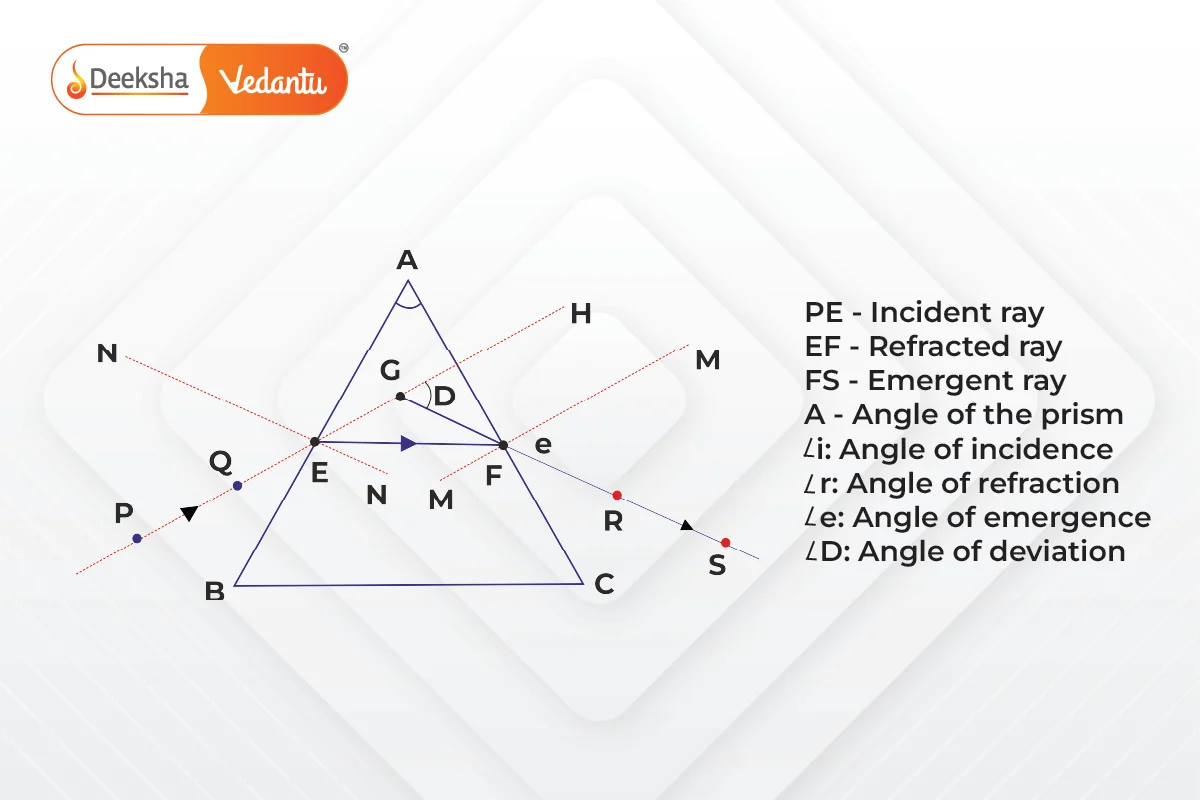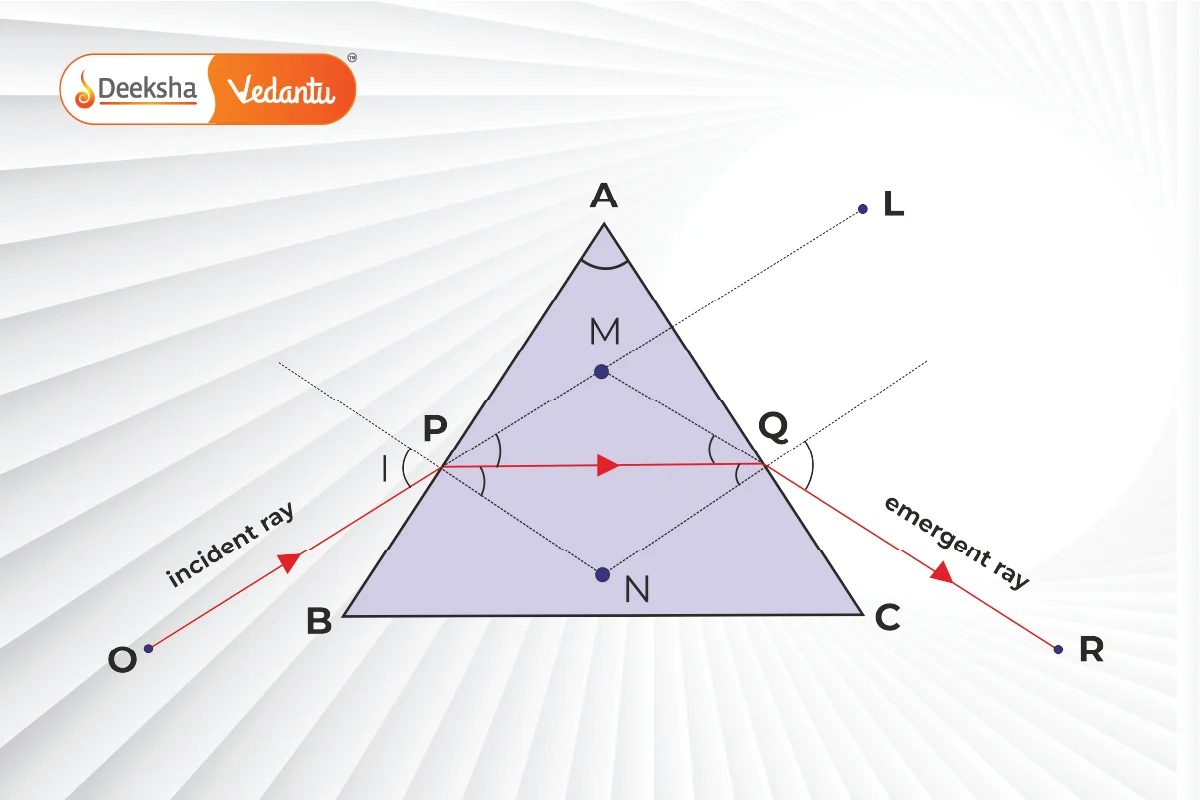Introduction
When light passes through different mediums, it bends or refracts. A prism, with its unique geometry, refracts light in such a way that it can also disperse light into its constituent colors. This subtopic explores how light behaves when it passes through a prism, focusing on the concepts of refraction, deviation, and dispersion.
What is a Prism?
A prism is a transparent optical object with two flat, triangular ends and three rectangular sides. It is typically made of glass or plastic and has a triangular shape, though it can have other polygonal bases. The key feature of a prism is that its refracting surfaces are not parallel to each other, which causes light rays to bend at different angles.
Structure of a Prism:
- Refracting Surfaces: The two plane surfaces that light enters and exits. These surfaces are inclined to each other at an angle.
- Base: The triangular face connecting the two refracting surfaces.
- Apex Angle: The angle between the two refracting surfaces at the top where they meet.
How Light Interacts with a Prism:
When light enters a prism, it undergoes refraction at the first surface (air-glass boundary). Inside the prism, the light bends due to the change in speed as it passes from air (a rarer medium) into glass (a denser medium). It refracts again when it exits the prism at the second surface (glass-air boundary), bending in a different direction.
Refraction of Light Through a Prism
Refraction through a prism involves two refractions: one when the light enters the prism and another when it exits. This refraction causes the light to deviate from its original path, creating an angular displacement between the incident and emergent rays.
Process of Refraction:
- Incident Ray: The light ray that strikes the first surface of the prism. When it hits the surface, it bends towards the normal because it is entering a denser medium (glass) from a rarer medium (air).
- Refracted Ray: The light ray travels through the prism and bends again when it reaches the second surface. As it exits the prism, it bends away from the normal because it is passing from a denser medium (glass) to a rarer medium (air).
- Emergent Ray: The refracted ray that emerges from the prism is called the emergent ray. The direction of this ray is different from that of the incident ray.
Key Concept – Angle of Deviation (δ):
The angle of deviation is the angle between the direction of the incident ray and the emergent ray. It is a measure of how much the light ray has been bent as it passes through the prism.
The angle of deviation depends on several factors:
- Angle of incidence: The angle at which light enters the prism.
- Refractive index of the prism material.
- Angle of the prism: The apex angle of the prism.
- Wavelength of the light: Shorter wavelengths (such as violet) are refracted more than longer wavelengths (such as red).
Mathematical Expression for the Angle of Deviation:
The angle of deviation is given by:
Where:
= Angle of incidence at the first surface,
= Angle of emergence at the second surface,
= Angle of the prism (apex angle).
Diagram of Refraction Through a Prism:

Dispersion of White Light Through a Prism
Dispersion is the splitting of white light into its constituent colors as it passes through a prism. This occurs because different colors of light have different wavelengths, and each wavelength refracts by a different amount. The phenomenon of dispersion leads to the formation of a spectrum of colors.
Why Does Dispersion Occur?
- White light consists of a mixture of different colors (wavelengths), with each color corresponding to a specific wavelength.
- When white light enters a prism, each color of light refracts by a different amount because the refractive index of the prism varies slightly for each wavelength. As a result, shorter wavelengths (such as violet) bend more than longer wavelengths (such as red), leading to the separation of colors.
The Spectrum of Light (VIBGYOR):
When white light is dispersed by a prism, it splits into the following colors, which are arranged in order of increasing wavelength:
- Violet (shortest wavelength, bends the most),
- Indigo,
- Blue,
- Green,
- Yellow,
- Orange,
- Red (longest wavelength, bends the least).
This sequence of colors can be remembered using the acronym VIBGYOR.
Key Concept – Refractive Index and Dispersion:
The refractive index of a material is different for each wavelength of light. Light with shorter wavelengths (like violet and blue) has a higher refractive index than light with longer wavelengths (like red and orange). This variation in refractive indices causes dispersion.
Diagram of Dispersion:

Natural Example – Rainbow Formation:
A rainbow is a natural example of dispersion. When sunlight passes through water droplets in the atmosphere, it undergoes refraction, dispersion, and reflection inside the droplet. This results in the formation of a colorful spectrum in the sky, which we observe as a rainbow.
Applications of Refraction Through a Prism
Prisms are widely used in various scientific and technological applications due to their ability to refract, deviate, and disperse light. Some of the key applications include:
Spectroscopy:
- Spectroscopes are instruments that use prisms to separate light into its component wavelengths. This helps scientists analyze the light emitted by substances to identify their chemical composition. Spectroscopy is used in fields like astronomy, chemistry, and physics.
Optical Instruments:
- Prisms are used in binoculars and cameras to redirect light, allowing users to view images correctly oriented. The Porro prism used in binoculars ensures that the image is upright when viewed through the eyepiece.
Periscopes:
- Periscopes used in submarines and tanks often use prisms to change the direction of light. This allows people to see over or around obstacles without being exposed.
Laser Technology:
- Prisms are used in laser systems to separate beams of different wavelengths. In some cases, prisms are used to combine or split laser beams for various applications, including communication, cutting, and medical procedures.
Corrective Optics:
- Prismatic lenses are used in glasses to correct certain vision defects, such as strabismus (crossed eyes). These lenses bend light to help align the images seen by each eye, improving vision.
Factors Affecting Refraction Through a Prism
Several factors influence how much light is refracted and deviated as it passes through a prism. These factors include:
Angle of the Prism (Apex Angle):
- The apex angle of the prism is the angle between the two refracting surfaces. A larger apex angle results in greater deviation of light because the light has to bend more as it passes through the prism.
Refractive Index of the Material:
- The refractive index of the prism material determines how much light will bend when it enters and exits the prism. A higher refractive index means greater bending of light, leading to a larger angle of deviation.
Wavelength of Light:
- Shorter wavelengths of light (such as violet and blue) are refracted more than longer wavelengths (such as red and orange). This is why violet light is deviated the most in a prism, and red light is deviated the least.
Angle of Incidence:
- The angle of incidence is the angle at which the light ray enters the prism. The angle of deviation increases as the angle of incidence increases, meaning that light entering the prism at a steeper angle will bend more.
Minimum Deviation Condition
A special case occurs when light passes symmetrically through the prism, meaning the angle of incidence is equal to the angle of emergence. In this condition, the angle of deviation is the smallest, and this is known as the minimum deviation condition.
Mathematical Expression for Minimum Deviation:
In this condition, the refractive index n of the prism material can be calculated using the following formula:
Where:
= Refractive index of the prism material,
= Angle of the prism,
= Minimum angle of deviation.
Diagram of Minimum Deviation Condition:

Practice Questions with Answers
Q1: What is the angle of deviation in a prism?
- Answer: The angle of deviation is the angle between the direction of the incident ray and the direction of the emergent ray after refraction through the prism. It indicates how much the light ray has been bent as it passes through the prism.
Q2: Why does white light split into different colors when it passes through a prism?
- Answer: White light splits into different colors because each color (wavelength) of light refracts by a different amount when passing through the prism. This phenomenon is called dispersion. Shorter wavelengths like violet are refracted more, while longer wavelengths like red are refracted less.
Q3: How does the angle of incidence affect the angle of deviation in a prism?
- Answer: As the angle of incidence increases, the angle of deviation also increases. The angle of deviation is smallest when the light passes symmetrically through the prism (the angle of incidence equals the angle of emergence).
Q4: What is the condition for minimum deviation in a prism?
- Answer: The condition for minimum deviation occurs when the angle of incidence is equal to the angle of emergence. In this case, the light passes symmetrically through the prism, and the angle of deviation is at its minimum.
Q5: How does the refractive index of the prism material affect the deviation of light?
- Answer: The higher the refractive index of the prism material, the more the light is bent as it passes through the prism. This results in a greater angle of deviation.
FAQs
Yes, prisms can be used to combine or separate different colors of light. In some optical instruments, prisms are used to merge multiple beams of light with different wavelengths into a single beam or to split light into its component wavelengths.
The refractive index of a prism is a measure of how much the prism slows down and bends light. It depends on the material of the prism and the wavelength of light.
Violet light has a shorter wavelength than red light, and light with shorter wavelengths is refracted more because it travels more slowly through the prism. This causes violet light to deviate more than red light.
Refraction is the bending of light when it passes from one medium to another. Dispersion is the splitting of white light into its constituent colors when it passes through a prism due to different refractive indices for different wavelengths.



![Rendered by QuickLaTeX.com \[\displaystyle \boldsymbol{n = \frac{\sin \left(\frac{A + \delta_{\text{min}}}{2}\right)}{\sin \left(\frac{A}{2}\right)}}\]](https://deekshalearning.com/wp-content/ql-cache/quicklatex.com-fa99d44a36d49c872bacf9bcbcaccf49_l3.png)



Get Social